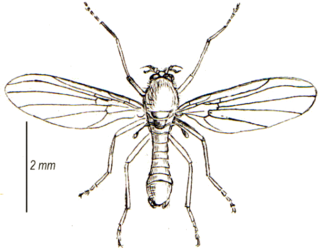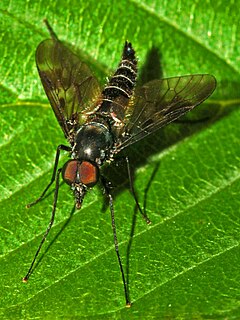
Thaumaleidae, the solitary midges or trickle midges, are a group of nematoceran flies related to the Ceratopogonidae, Chironomidae, and the Simuliidae. They are small, stocky, yellow to brown flies (3–4 mm). Very few species are known for this family. Larvae are found in films on rocks and the nonfeeding adults are usually found on foliage along the same streams in which the larvae are found. A few solitary midges are found in the Southern Hemisphere, but Thaumaleidae are generally an Holarctic family.

The Brachyceran family Vermileonidae is a small family of uncertain affinities and unusual biology. It includes fewer than 80 described species, most of them rare and with restricted distribution, in 10 genera. Historically the vermileonids had been regarded as belonging to the family Rhagionidae, possibly in a subfamily Vermileoninae. Their biology and morphology are so markedly distinct from the main Rhagionidae sensu stricto however, that the placement as a separate family has been widely accepted.

Chrysopilus is common, worldwide genus of predatory snipe flies. There are approximately 300 species in the genus, including fossil members that are sometimes found in amber.

Rhagionidae or snipe flies are a small family of flies. They got their name from the similarity of their often prominent proboscis that looks like the beak of a snipe.

Rhagio is a worldwide genus of predatory snipe flies. Several species in this genus are referred to as downlooker or down-looker flies because they sometimes perch on tree trunks in a head-down position. There are approximately 170 species. They can be distinguished from other rhagionids by the open anal cell on the wings and the lack of a kidney-shaped arista.

Athericidae is a small family of flies known as water snipe flies or ibis flies. They used to be placed in the family Rhagionidae, but were removed by Stuckenberg in 1973. They are now known to be more closely related to Tabanidae. Species of Athericidae are found worldwide.
Chaetostomella is a genus of fruit flies in the family Tephritidae.
Rhochmopterum is a genus of tephritid or fruit flies in the family Tephritidae.
Austroleptis is a genus of snipe flies, and the sole genus in the family Austroleptidae; until 2010, it was placed in the family Rhagionidae. They are small to moderately sized flies of around 3 to 7.7 mm.
Alloleptis is a genus of snipe fly of the family Rhagionidae. It is a small fly of about 4 mm and only known from Sulawesi. It currently contains only one species, Alloleptis tersus.
Arthroceras is a genus of snipe fly of the family Rhagionidae. Arthroceras are mid-sized to large 4.5 to 13 millimetres, black, grey, or yellowish-colored flies that have a fairly long, tapering antenna consisting of 5–8 flagellomeres. Within Rhagonidae, the genus is sometimes(?) placed in the subfamily Arthrocerinae, in which it is the only genus.
Atherimorpha is a genus of snipe fly of the family Rhagionidae.
Schizella is a genus of snipe flies of the family Rhagionidae. They are delicate flies from 3.7 to 6.3 mm, with long, thin legs, and the thorax is brown to orange-brown with blue, purple, or golden-coloured setae.

Rhagioninae is a worldwide subfamily of predatory snipe flies.

Sphenella is a genus of the family Tephritidae, better known as fruit flies.

Atherix is a genus of 'ibis flies' belonging to the family Athericidae, a small family very similar to the Rhagionidae. Species within this genus are present in most of Europe and also in the Nearctic realm. There are at least 30 described species in Atherix.
Vermipardus is a genus of wormlion in the family Vermileonidae.
Vermilynx is a genus of wormlion in the family Vermileonidae.
Leptynoma is a genus of wormlion in the family Vermileonidae.
Lampromyia is a genus of wormlion in the family Vermileonidae.







